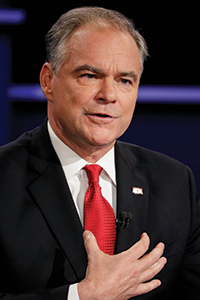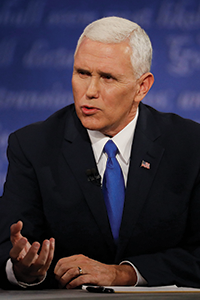How many U.S. vice presidents can you name?
“Once there were two brothers. One ran away to sea, the other was elected vice president, and nothing was ever heard of either of them again.”
— Thomas R. Marshall, vice president under President Woodrow Wilson
“The vice presidency is not worth a bucket of warm spit.”
— John Nance Garner, vice president for two terms under President Franklin Roosevelt
When Tim Kaine was winding up his term as Virginia’s governor in 2010, he said he didn’t expect to seek elective office again.

 But his retirement proved to be short-lived. Now a U.S. senator, he is the Democratic Party’s vice presidential nominee. Win or lose in this election, Kaine and his Republican counterpart, Indiana Gov. Mike Pence, are automatically presumed to be future presidential candidates.
But his retirement proved to be short-lived. Now a U.S. senator, he is the Democratic Party’s vice presidential nominee. Win or lose in this election, Kaine and his Republican counterpart, Indiana Gov. Mike Pence, are automatically presumed to be future presidential candidates.
The question each faces is: Will it help or hurt my political career to become vice president?
Many of the forgotten vice presidents elected in the past 227 years shared Marshall and Garner’s view that the vice presidency is a political black hole.
Want some proof? Here is a list of some of the distinguished men who have filled the job: George Clinton, Richard Mentor Johnson, George M. Dallas, Henry Wilson, Levi P. Morton, Charles G. Dawes and Charles Curtis. Recognize any of them?
The only duty that the U.S. Constitution gives the vice president is to preside over the Senate. Michael Barone, the co-author of “The Almanac of American Politics” hints that the scanty responsibilities of the post may have been an oversight. “The Framers of the Constitution created the office near the end of their deliberations,” he notes in a Wall Street Journal column.
Unlike the speaker of the house, who also presides over a congressional body, the vice president has no control over the members of the Senate. In fact, other than breaking a tie vote in the Senate, the only real power that a vice president has is what the president is willing to share.
The insignificance of the vice president’s constitutional duties, however, doesn’t negate the one reason the office exists. Vice presidents are a “heartbeat away from the presidency,” and they have taken over in emergencies nine times in our history. On four occasions the president was assassinated. On another four, the president died of natural causes. And of course, there was one resignation when Vice President Gerald Ford succeeded Richard Nixon in 1974.
Because the transfer of power can be unexpected, you would think the presidents would at least get along with their vice presidents and keep them informed. Too often, however, the choice of running mate is driven by political expediency. The result is an odd couple.
In his book “The American President,” historian William Leuchtenburg notes Democratic Party bosses became alarmed about President Franklin Roosevelt’s health as the 1944 election approached. Many believed that the president’s running mate would likely succeed him before the end of Roosevelt’s fourth term.
The party pushed Roosevelt to replace his left-leaning vice president, Henry Wallace, with the more moderate Sen. Harry Truman of Missouri. The bosses’ prediction came true. Truman became president when Roosevelt died at 63 of a cerebral hemorrhage in April 1945.
Truman was “woefully uninformed,” Leuchtenburg says. In the 82 days he had been vice president, Truman talked to Roosevelt only twice outside of Cabinet meetings. The new president, in fact, knew nothing about the development of an atomic bomb until after his first Cabinet meeting. His decision to drop the bomb four months later would end World War II.
Dwight Eisenhower was 62 when he was elected president in 1952. His running mate, Nixon, wasn’t yet 40. But their pairing on the Republican ticket had nothing to do with concerns about Eisenhower’s health. The retired five-star general didn’t care for his running mate, who was picked by party pols to appease its conservative wing. Eisenhower, in fact, tried to dump Nixon before the election.
Nonetheless, they would serve two terms together, during which Eisenhower suffered a heart attack and a stroke. When Nixon ran for president in 1960, reporters asked Eisenhower, “Can you think of a major contribution that Nixon has made to your administration?” The president replied, “Well, if you give me a week I might think of one.” The remark became ammunition in John Kennedy’s winning campaign.
Barone asserts that the situation for vice presidents has changed in the past 40 years. The turning point came in 1976 when former Georgia Gov. Jimmy Carter asked Minnesota Sen. Walter Mondale to be his running mate on a winning ticket. Conscious of the humiliation suffered by his friend, Hubert Humphrey, as Lyndon Johnson’s vice president, Mondale insisted on making his vice presidency “a useful instrument of government.” Under Carter, he was given high-level intelligence briefings, an independent staff and permanent access to the president.
That precedent created a pattern that has continued down to Joe Biden today, Barone says.
But how well has the job served as a launching pad for the presidency? Only one of the five vice presidents elected since 1976 made it to the Oval Office, George H. W. Bush. He, however, was beaten in his bid for re-election, garnering only 37.4 percent of the vote in a three-way race.
So who has been winning the top job during the past four decades? Former governors: Carter, Ronald Reagan, Bill Clinton and George W. Bush. Only Carter failed to serve two terms.
Maybe Kaine and Pence should have stuck with their gubernatorial records if they want to be president.

















